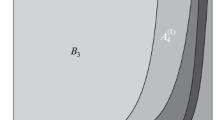Abstract
Potential flow of 3He through a nematic aerogel of spherical shape is considered. A characteristic feature of the system under consideration is that the superfluid phases inside and outside the aerogel may be different. In particular, the cases are considered when the polar phase of superfluid 3He is implemented inside the aerogel, while, outside the aerogel, there exists either the B or the A phase of superfluid 3He. Under the condition that the order parameter of the system is a continuous function of the spatial coordinate without singular points and lines on the aerogel surface, as well as that there are no Josephson currents through the aerogel surface, boundary conditions needed for the hydrodynamic description of the flow are obtained for the phase of the order parameter on the aerogel surface. With the use of these boundary conditions, the added mass tensor of the potential flow of a fluid is found in the cases under consideration. A comparison with available experimental data is made.


Similar content being viewed by others
REFERENCES
K. Aoyama and R. Ikeda, Phys. Rev. B 73, 060504(R) (2006).
V. V. Dmitriev, A. A. Senin, A. A. Soldatov, and A. N. Yudin, Phys. Rev. Lett. 115, 165304 (2015).
V. V. Dmitriev, M. S. Kutuzov, A. A. Soldatov, E. V. Surovtsev, and A. N. Yudin, JETP Lett. 112, 780 (2020).
L. D. Landau and E. M. Lifshitz, Course of Theoretical Physics, Vol. 6: Fluid Mechanics (Nauka, Moscow, 2005; Pergamon, New York, 1987).
C. Gabay, P. E. Wolf, and L. Puech, Phys. B (Amsterdam, Neth.) 284 (2000).
P. Brussaard, S. N. Fisher, A. M. Guenault, A. J. Hale, N. Mulders, and G. R. Pickett, Phys. Rev. Lett. 86, 4580 (2001).
L. D. Landau and E. M. Lifshitz, Course of Theoretical Physics, Vol. 8: Electrodynamics of Continuous Media (Nauka, Moscow, 2005; Pergamon, New York, 1984).
D. Vollhardt and P. Wölfle, The Superfluid Phases of 3 He (Taylor and Francis, London, 1990).
ACKNOWLEDGMENTS
I am grateful to I.A. Fomin, V.V. Dmitriev, and A.A. Soldatov for useful discussions of the results of the work.
Funding
This work was supported by the Russian Science Foundation, project no. 18-12-00384.
Author information
Authors and Affiliations
Corresponding author
Additional information
Translated by I. Nikitin
APPENDIX
APPENDIX
In the case when the B phase exists outside the aerogel, the result obtained can be generalized to an elliptical body under the assumption that the aerogel moves along one of the principal axes of the ellipsoid. The main idea is that the problem is similar to the problem of a dielectric body in a uniform electric field. In our problem, Ai can be associated with the dipole moment in the problem of a dielectric body. Since the dipole moment of a body is invariant with respect to the Galilean transformation, we can use the well-known result from [4], in which the dielectric permittivities should be replaced by the superfluid density tensors of the external and internal states of the system. As a result, we have
where α is the “demagnetization” factor of the body in the direction of the flow (α = 1/2 for a ball) and V0 is the volume of the body.
Now, let us obtain an expression for the added mass tensor of elliptical aerogel. The first three terms in (44) remain the same, and the last term can be calculated as follows [4]:
where df = –nr2dΩ is an oriented element of the body surface. Using the boundary conditions, we can rewrite the integral as
and, after straightforward transformations, we obtain
We write the final expression for the kinetic energy as
Thus, we obtain the following form of the added mass tensor for a nematic aerogel of elliptical shape:
Rights and permissions
About this article
Cite this article
Surovtsev, E.V. Potential Flow of Superfluid 3He through a Nematic Aerogel of Spherical Shape. J. Exp. Theor. Phys. 133, 477–487 (2021). https://doi.org/10.1134/S106377612110006X
Received:
Revised:
Accepted:
Published:
Issue Date:
DOI: https://doi.org/10.1134/S106377612110006X




